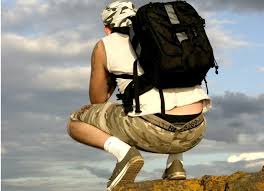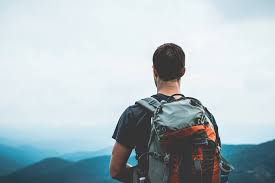50l backpack big enough

When it comes to travelling for the first time, other than maybe buying a plane ticket I reckon there’s nothing that tells you that you’re really ‘doing it’ more than going into the store and buying your backpack. Striding up to the counter, credit card in hand and a big smile on your face, proudly telling the poor shop assistant exactly what it is that you plan to do with your new purchase. “Oh, I’ll be carrying this for six months around Europe”, you happen to slip into the conversation. “I hope this is big enough to fit in everything I need for my round the world trip”, you proudly proclaim. As with all important purchases, however, it’s vital to pick the right option. Especially when that option is going to be sitting on your back with all of your possessions in it for the next several weeks, months or years. Getting it wrong will almost certainly result in frustration and unnecessary expense, limit your options and probably provide you with a visit to the chiropractor to boot.

Here’s a few pointers that I’ve come up with over the years that I wish I’d known when hitting the travel stores for the first time. Like a few other things in life, size matters when it comes to choosing a backpack – but probably not in the way you think. Based on many years of dragging excessively large backpacks around the world, I have to say bigger is not better. You do not need an 80 or 90 litre pack. No really, you don’t. No matter how much you tell yourself that you won’t fill it up, or it really isn’t that big, or the extra space is ‘just in case’, or whatever your justification is, the reality is that if you don’t have the space to start with, you’re not tempted to pack things that you don’t absolutely need. Trust me, your back will thank you for it as you’re climbing the 150th stair out of a tube station in London, or walking to a campsite in Rome that’s a few km out of town because you got off the bus in the wrong place. These things will happen, and if you’re not carrying around half your bodyweight on your back at the time, you’ll be a lot happier for it.

Find the smallest size that you think that you can get away with – and then choose the size below that. Even if you can’t get away with carry-on size luggage, a 55 or 60 litre pack is plenty big enough for even the longest trip if you pack well. No, not in, on or with your backpack (although whatever works for you, I guess), but rather what sex you are. As you may have noticed, boys and girls have sticky-out bits in different places, and good backpacks are designed with that fact in mind. Ask the sales assistant to show you the packs that are designed for your gender – one size does not fit all, especially if you’re female. As a general rule there are three main types of backpack – the hiking pack, the travel pack, and variations on the ‘backpack with wheels’ theme. Unless I was actually planning on spending several days or weeks walking and camping in the bush, I really wouldn’t buy a pack designed primarily for hiking. For starters, they usually open only from the top, which aids in waterproofing at the expense of, y’know, actually being useful.

I don’t know about you, but I’ve haven’t found the need to ford too many waist-high rivers while exploring New York City.
tulu backpackI have, on the other hand, needed to get things from the bottom of my pack on a very regular basis.
illuminated backpack billboardsAfter pulling everything out and dumping it on the sidewalk for the third time in a day, I suspect you’ll be a little less than enamoured with your hiking pack.
microsoft ignite backpack These packs also tend not to have the option of attaching a daypack to them, which means that you’ll either not be carrying one (impractical) or wearing it on your front (not much better).
kuka backpack
Finally, hiking packs usually don’t have a zip-away section at the front to stow the straps when being checked onto a plane, which increases the likelihood of (a) the pack getting damaged and (b) the check-in assistant giving you a very dirty look. The latter may not matter much to you, but the former definitely does. Carrying a pack with two straps can be bad enough. Doing it with one (or none) is just torturous. A backpack with wheels is another option, often pitched by sales assistants as ‘the best of both worlds’. Sadly I doubt that anyone that says that has actually tried travelling with one, as in reality they are more like worst of both worlds. Every one that I’ve come across seems to be too heavy, very uncomfortable, and generally impractical for everyday use as either a backpack or a suitcase. The best travel packs have a panel design that allows easy access, plenty of internal pockets for storing bits and pieces, a comfortable strap and harness mechanism that zips away when not required and both a shoulder strap and a top or side handle to give different carrying options.

Realistically, these are far and away the best choice. For the first few years that I travelled, I always took a sleeping bag with me. After using it maybe five percent of the time, these days I don’t bother unless I absolutely know that I’ll need it. Despite that, however, I’ll always look for a pack with a sleeping bag storage compartment at the bottom. Other than it being the obvious place to put your sleeping bag on the odd occasion that you actually do need it, it’s a great place to throw muddy shoes, dirty or wet clothes, and other stuff that you don’t want mixing with the rest of the things in your pack. There’s nothing worse than having all of your clean laundry covered in dirt and smelling like damp dog. Unless that’s your thing, of course. If you can find a pack where the internal lining extends all the way into the storage compartment when it’s not in use, even better. This one may seem obvious, but it’s surprising how many people don’t seem to think about it.

Make sure that when you’re checking out which pack to buy, that you try it on with weight in it. Fill it up with all sorts of random stuff from the travel store – sleeping bags, jackets, boots, whatever you can find. Full packs sit differently on your back to empty ones, and what seems comfortable off the rack may not be with 10 or 15kg of gear in it. A couple of minutes spent now can save you hours of pain on the other side of the world. Good quality backpacks can be expensive, and it’s always tempting to try to save money wherever possible to spend on important things like beer. While I certainly wouldn’t say that you need a brand name pack, spending a little extra on quality will save you immeasurable grief in the long run. Trust me, you won’t be slapping yourself on the back for saving a hundred bucks when your zip jams or your strap breaks a few thousand miles away from the nearest warranty claim centre. Compare all of the packs on display at the store, and see if you can figure out what makes the expensive ones so pricey.

Is it just the name, or are the zips and buckles noticeably more robust? Pull the zippers backwards and forwards a dozen times – if they keep jamming, move on to the next pack. Same with the buckles and clasps. Tighten and loosen the straps several times, and make sure they slide easily and stay in position once locked in place. Check the quality of both the exterior material and the inner linings, and avoid any that are noticeably inferior. Take the time to google for other people’s experiences – they are worth far more than anything the sales person might have to say. Once you’ve finally settled on the one that you’re after, negotiate hard and don’t be afraid to shop around for the best price. Your pack will be one of the most important pieces of travel equipment that you ever buy, so be prepared to spend a bit of time and money finding the perfect one for you. Once you’ve bought it – celebrate! You’re one vital step closer to starting the adventure of a lifetime!